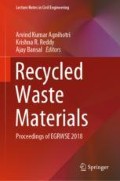Abstract
In the construction field, cement is one of the most commonly used materials for concrete production, wherein 5–7% of globally anthropogenic CO2 emissions are contributed in this process. Agricultural and industrial fields produce various types of Supplementary Cementitious Materials (SCMs) as wastes, which otherwise can be used as a replacement in cement for concrete production. In the present context, rice straw, which is a by-product of the rice plant, is subjected to open burning which causes numerous health and environmental problems. Moreover, Electric Arc Furnace (EAF) dust produced from steelmaking processes contains heavy metals, which is being dumped in landfill. Considering the severe impact of the above-highlighted issues, it has thus become the need of the time to identify the feasibility of waste integration in concrete production. The objective of the current study is to utilize the mixture of rice straw ash and electric arc furnace dust in cement at fixed 10% partial replacement criteria for feasibility analysis. The test results obtained shows that there is a marginal difference between the compressive strength of concrete casted with and without replacement. However, the concrete casted with 10% replacement of cement is still preferable for casting.
Access this chapter
Tax calculation will be finalised at checkout
Purchases are for personal use only
References
Alizadeh R, Chini M et al (2003) Utilization of electric arc furnace slag as aggregates in concrete—environmental issue. In: Proceedings of the 6th CANMET/ACI international conference on recent advances in concrete technology, Bucharest, Romania, June 2003, pp 451–464
Al-Khaja W (1997) Effect of sludge ash on the mechanical properties of concrete. Model Meas Control B Solid Fluid Mech Thermics Mech Syst 63(1):9–14
Balderas A, Navarro H, Flores-Velez LM et al (2001) Properties of Portland cement pastes incorporating nanometer-sized franklinite particles obtained from Electric-Arc-Furnace Dust. J Am Ceram Soc 84(12):2909–2913
Binod P, Sindhu R et al (2010) Bioethanol production from rice straw: an overview. Biores Technol 101(13):4767–4774
Chen QY et al (2007) Characterisation of products of tricalcium silicate hydration in the presence of heavy metals. J Hazard Mater 147(3):817–825
El-Sayed MA, El-Samni TM (2006) Physical and chemical properties of rice straw ash and its effect on the cement paste produced from different cement types. J King Saud Univ 19:21–29
Gibbs M, Soyka P et al (2001) CO2 emissions from cement production. In: Good practice guidance and uncertainty management in National Greenhouse gas inventories, pp 175–182
Guézennec AG, Huber JC, Patisson F et al (2005) Dust formation in electric arc furnace: birth of the particles. Powder Technol 157(1–3):2–11
Hutchinson TC, Meema KM (1987) Human health concerns of lead, mercury, cadmium and arsenic. In: Hutchinson TC (ed) Lead, mercury, cadmium and arsenic in the environment, 1st edn. Wiley, UK, pp 53–68
Lim JS, Manan ZA et al (2012) A review on utilisation of biomass from rice industry as a source of renewableenergy. Renew Sustain Energy Rev 16(5):3084–3094
Magalhães MS, Faleschini F, Pellegrino C et al (2017) Cementing efficiency of electric arc furnace dust in mortars. Constr Build Mater 157:141–150
Manso JM, Gonzalez JJ, Polanco JA (2004) Electric arc furnace slag in concrete. ASCE J Mater Civil Eng 16:639–645
Marsh BK, Day RL et al (1985) Pore structure characteristics affecting the permeability of cement paste containing fly ash. Cem Concr Res 15(6):1027–1038
Mehta PK (1983) Pozzolanic and cementitious byproducts as mineral admixtures for concrete—a critical review. Special Publication 79:1–46
Mujedu KA, Adebara SA, Lamidi l (2014) The use of corn cob ash and saw dust ash as cement replacement in concrete works. Int J Eng Sci (IJES) 3(4):22–28
Munshi S, Dey G et al (2013) Use of rice straw ash as pozzolanic material in cement mortar. IACSIT Int J Eng Technol 5(5):603–606
Papadakis VG, Fardis MN et al (1992) Hydration and carbonation of pozzolanic cements. Mater J 89(2):119–130
Sikalidis C, Mitrakas M (2006) Utilization of electric arc furnace dust as raw material for the production of ceramic and concrete building products. J Environ Sci Health Part A 41(9):1943–1954
Tashima MM, Akasaki JL, Barbosa MB (2004) The possibility of adding the rice husk ash (RHA) to the concrete. In: Proceedings of the 2004 international RILEM conference on the use of recycled materials in building and structures, pp 778–786, November 2004
US Geological Survey (2018) Major countries in worldwide cement production from 2012 to 2017 (in million metric tons). https://www.statista.com/statistics/267364/world-cement-production-by-country/. Accessed 3 March 2018
UN-Water WWAP (2006) Green fact: facts on health and environment. Water Resour. http://www.greenfacts.org/en/water-resources/l-2/5-growing-demand.html
Urmila (2017) Crop burning against the environment. Int J Human Social Sci Res 3(8):16–19
Zafar S (2015) Biomass resources from rice industry. Bioenergy Consult. https://www.bioenergyconsult.com/biomass-resources-rice-industry
Author information
Authors and Affiliations
Corresponding author
Editor information
Editors and Affiliations
Rights and permissions
Copyright information
© 2019 Springer Nature Singapore Pte Ltd.
About this paper
Cite this paper
Singh, R., Sodhi, A.K., Bhanot, N. (2019). Investigation on the Potential Use of EAF Dust and RSA for Sustainable Concrete Production. In: Agnihotri, A., Reddy, K., Bansal, A. (eds) Recycled Waste Materials. Lecture Notes in Civil Engineering , vol 32. Springer, Singapore. https://doi.org/10.1007/978-981-13-7017-5_15
Download citation
DOI: https://doi.org/10.1007/978-981-13-7017-5_15
Published:
Publisher Name: Springer, Singapore
Print ISBN: 978-981-13-7016-8
Online ISBN: 978-981-13-7017-5
eBook Packages: EngineeringEngineering (R0)

